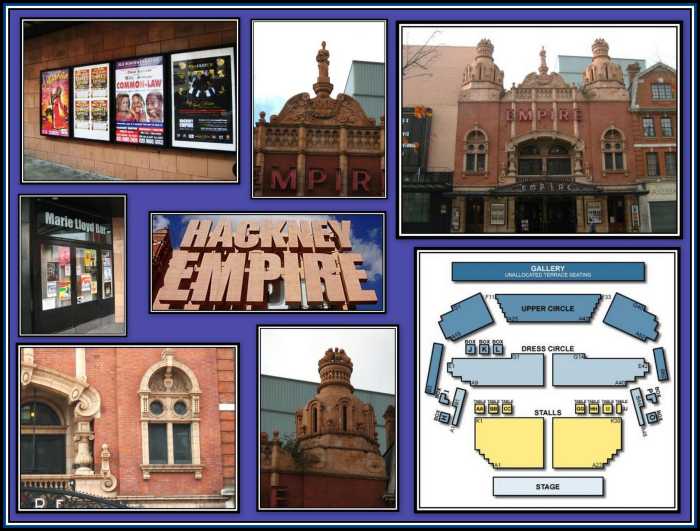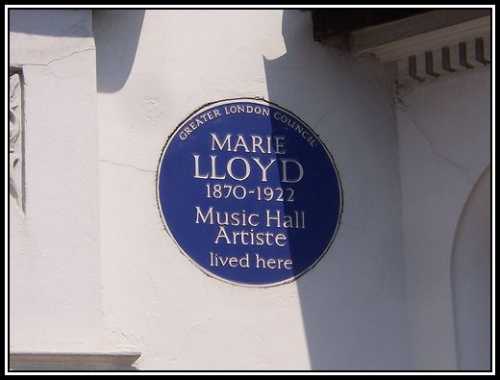| It has
been many years since I
went to the Hackney
and sat in a fort-tell
or Box J. Upon
reflection, I am sure
that my memories have
been clouded and
distorted with the
passage of time and have
become perhaps more than
a little glorified.
However, despite the
distortions and
glorifications caused by
the passage of time, the Hackney
will always hold a
very special place in my
memory and in my heart.
As far as I am concerned,
the importance of the Musical
Hall circuit and the Hackney
in particular, is that it
exposed and introduced me
to a range of
entertainments –
to variety in
fact, in its true
definition. As a child, I
watched many types of
acts – some good,
some bad, some memorable
and many forgettable.
However, each left or
added to an impression on
me by exposing me to a
variety of types of music
and entertainment forms. It
was at the Hackney
that I first saw ballet.
I am sure that it was not
a particularly good
example of it, but none
the less by seeing that troupe
of young girls in short
white skirts on points
and men in tights make
their way across the
stage, I became interested
and full of questions
about what on earth
they were doing,
which my parents tried
their best to answer.
Trips to the library and
then to the Stoll
Theatre further
exposed me to this type
of dance and allowed me
to see The Festival
Ballet and a
performance of Where
the rainbow ends and
an opportunity to see
Anton Dolin leap through
an open window and into a
young woman’s
bedroom in spectacular
fashion.
On a more
lighthearted note, it was
at the Hackney
that I first heard that
part of Offenbach’s Orphee
aux enfers and
totally fell in love with
a gang of swirling,
twirling, leaping,
cavorting danseuses
as they swept across the
stage in the midst of
yelps and squeals in
apparent chaos. I was
told that I became very animated
during the dance and
needed restraining since
I wanted to jump up to
fling myself into the
leaping with the women in
their amazing dance. Some
years later I learned
that this dance used to
be performed around the
audience, as they stood
on the dance floor of the
Moulin Rouge in
wonderment. If I have any
regrets in my life, it is
not having been alive
then as I would have
enjoyed being one of les
anglais au bal du Moulin
Rouge that had his
top hat kicked from his
head by a lovely black
silk stocking covered leg
belonging to some
audacious danseuse.
It was
also at the Hackney
that I heard my first aria
sung in Italian.
Again I expect that it
was not of the level that
would be acceptable at Covent
Garden, but it was
sung in another language,
and this allowed me to
learn that not everyone
in the world spoke English.
As a result of my
exposure to different
forms of entertainment
– to variety
– I happily credit
the Hackney and
acknowledge these initial
exposures with giving me
the opportunity to
develop an eclectic
taste.
My first
realization that times
were changing came in
the summer of 1955 when I
noticed the large play
card on Bethnal Green
Road where the Hackney
used to advertise its
latest production
carrying a particular
ominous proclamation. In
place of next
week’s production,
appeared the news that
the Hackney would
be CLOSED FOR VACATION.
What was a VACATION?
I had never heard this
word before. I remember
looking the word up in a
dictionary and was
horrified to find out the
meaning. I did not
understand. Why did the Hackney
need a holiday?
Did all the employees
want to take their
holidays at the same
time? This, of course,
was the thin end of
the wedge. Worse was
yet to come.
In 1956,
we moved from the East
End of London to one of
those new towns
that were engulfing old
towns about London
and so our frequent trips
to the Hackney came
to an end. Although our new
town was only
eighteen miles from
London, in those days,
this was no short
distance. I am still
surprised to think that
the journey from where I
lived to London now takes
only about twenty minutes
if the motorway is taken.
Once we moved, we would
visit London and make
trips to the East End
occasionally and would
sometimes pass by the Hackney.
The place would still be
standing, which was no
mean achievement then as
many of the old Empires
were either closed or
about to close. I watched
with regret as the
Finsbury Park Empire was
demolished - then The
Metropolitan in the
Edgware Road – next The
Collins, which
claimed to be
London’s oldest Music
Hall – and then
Wood Green, East Ham
……….. on
and on it went. Old long
and forgotten devastated Empires
and derelict theatres,
victims of the Second
World War were also, at
last, being demolished to
make way for more office
buildings: the Gaiety
in the Strand, the Holborn
Empire, and two
nameless dilapidated
theatres in the Hackney
Road and in Stratford
that I only ever knew as burned
out shells. It was a
miserable time for the Music
Hall.
The
mid-1950’s was a
time for television. Here
Variety was being
presented at no cost
to the viewer. The
need to attend a theatre
was no longer required to
be entertained. Soon
cinemas would be closing
too and would be turned
either into Bingo
Halls or Leisure
Centres or else would
be demolished to make way
for new buildings. Worse
yet, many spectacular
theatres and cinemas each
of architectural wonder
were left to rot away
with time. A few can
still be found rotting
away today in South
London as well as in
other parts of the
country.
The Hackney
did not suffer this fate.
What had helped bring
about the demise of Music
Hall actually saved
the Hackney from
demolition. The new
commercial television
company, the Independent
Television Authority,
ITV, used it for a while
to produce some of its
programmes. ITV’s
answer to the BBC’s 6-5
Special, was called
Oh Boy and was
produced at the Hackney
as were some episodes of
the early medical serial,
Emergency Ward Ten.
As television developed
and evolved, it outgrew
the Hackney. Again
it was saved from
demolition and became a Mecca
Bingo Hall. Although
it was saved, the
interior apparently
became painted in orange
and black and the
wonderful décor was
temporarily lost. In
addition, the balcony was
gutted and left to
rot. But even its usage
here did not last and it
was once again threatened
with the wrecking
ball.
Have you
noticed that the trouble
with clichés is
that often they are true?
One such cliché
states that every
cloud has a silver lining.
Well, as hacknied
as this old saying is,
when it comes to the Hackney,
it has turned out to be
true. As a result of the
hard work and great
effort of a number of unsung
heroes, the threat of
demolition mustered a
number of valiant men and
women to rally to
the call and the Hackney
was saved. And like a
phoenix, has risen once
more from the ashes.
You may feel that these
are dramatic and perhaps
slightly exaggerated
words. Well, perhaps they
are, but this is how I
feel each time I hear
that the Hackney is
still in business. The Hackney
brought me many happy
memories during my
childhood and helped
determine and develop
some of my interests. I
cannot over emphasize the
pleasure that each trip
there brought my family
and me.
A few
years back, I went to see
a production of Hamlet
on Broadway. It was a
production from Britain
and starred Ralph Fiennes
in the title role. I was
very proud to attend this
production and made sure
that everyone about me
knew that this production
had been imported after
playing at the great Hackney
Empire. I also made
certain that everyone
within earshot learned
something of the history
of this wonderful
theatre.

It gives
me great pleasure to know
that the Hackney
has been renovated,
thanks to contributions
from the public and from
the generosity of the National
Lottery and has
regained its position as
a living theatre and so
can continue to be a
vital part of the life of
Hackney. I wish all those
involved in its
maintenance and all those
who are working hard to
bring further success to
the theatre the very best
of luck in all future
endeavours. I hope that
the theatre will continue
to live and thrive
and make many vital
contributions to theatre.

Marie
Lloyd, considered by many
to be the greatest Music
Hall entertainer of all,
came from Hoxton.
In the early 1970s, a
plaque of remembrance was
placed on the house where
she lived.
This picture was
provided by Mr. Duncan
Rimmer.
Incidentally, Marie Lloyd
was a relative of my
mother.
|